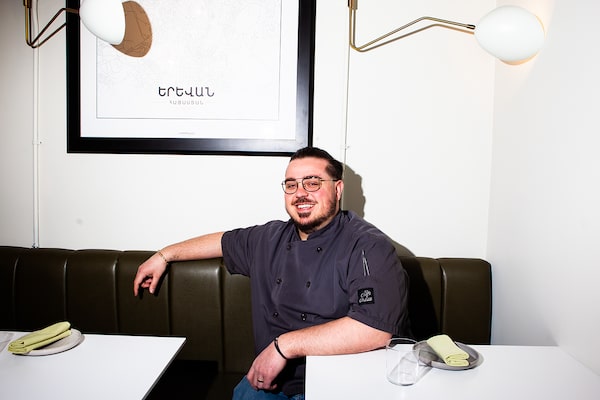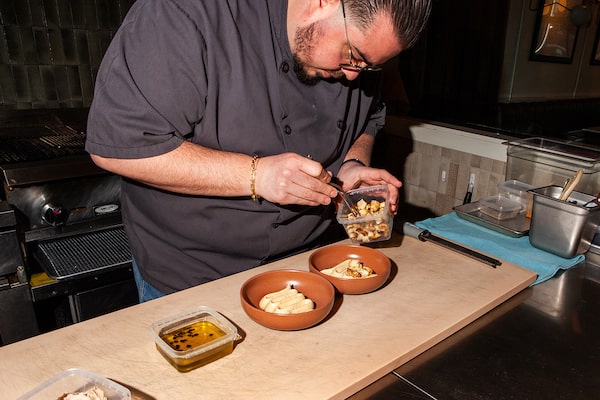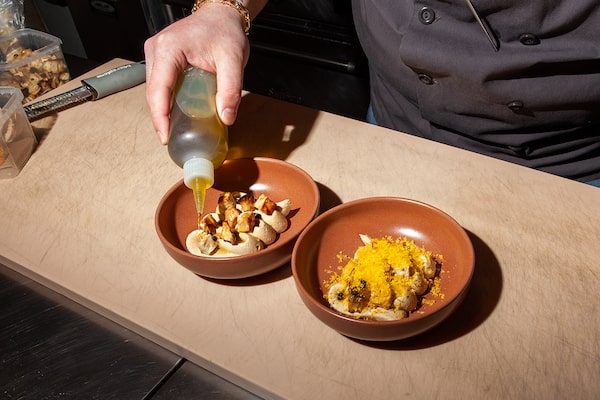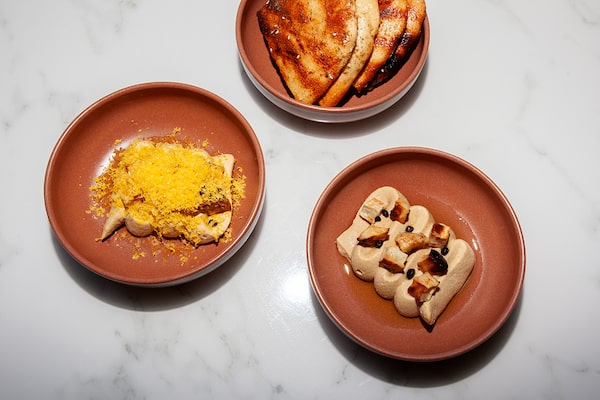
Sebouh Yacoubian, executive chef and partner at Toronto-based Armenian restaurant Taline.SARAH PALMER
Dietary restrictions for lifestyle, health or religious reasons are on the rise. A 2020 study by Dalhousie University found that more than 10 million Canadians identified themselves as being on a meat-restricted diet. About three million cited allergies to foods such as nuts, seafood and eggs, and seven million with intolerances like dairy and gluten, which occur when the body can’t digest them properly.
Between 2018 and 2020, the study determined the amount of people eating a meat-restricted diet had increased 59 per cent. “Recent research and changes to Canada’s Food Guide in 2018 likely amplified choosing more plant-based foods,” says Lesley Seto, a registered dietitian in Halifax. “And a larger influx of immigrants to Canada in the last few years has also changed the food scene. Halal and kosher are good examples. Another is the number of immigrants from India in the last few years, where vegetarian eating is more common.”
Shifting eating habits also impacts Canada’s $110-billion restaurant industry. On a recent Tuesday, Sebouh Yacoubian, executive chef and partner at upscale Toronto Armenian restaurant Taline, said that “out of the 12 tables we have, six of them have dietary restrictions.”
Diners can often find menu items that cater to their needs (think celiac patrons choosing a dish that is naturally gluten-free, for example), but restaurants are frequently asked to adapt their other dishes to suit the needs of multiple dietary requirements.

Chef Yacoubian prepares a hummus dish with black garlic, celeriac and shaved dehydrated egg yolk at Taline restaurant in Toronto. The vegan option would be without a dehyradated egg yolk on top.SARAH PALMER
Is asking for changes disruptive to chefs?
Yacoubian, as well as Angus An, chef and owner of Maenam, a Michelin-recommended Thai eatery in Vancouver, agree it isn’t, as long as diners let restaurants know in advance.
“If someone doesn’t tell you ‘I’m celiac’ until they get to the restaurant when you’re in the middle of a busy service, you’re bringing out a whole new cutting board, you’re asking the dishwasher to wash all the utensils,” Yacoubian says. “It’s a lot of work to make it safe, so it’s always appreciated if guests inform us in advance.”

Preparation of a hummus dish with black garlic, celeriac and shaved dehydrated egg yolk at Taline restaurant in Toronto. The vegan option, left, will not have egg yolk on top.SARAH PALMER
Both chefs agree that some dishes are easier than others to adapt for certain diets. An says sauces are easy to change when they’re made in-house because there’s “control over what ingredients go in it.” Yacoubian serves a lamb dish with yogurt, which can easily be removed.
Other changes are more complicated, and requests should be within reason. Especially when it comes to fine-dining, where chefs are creating very specific experiences. “Our beef-cheek green curry will be braised by the green curry,” An says. “So, if you don’t eat beef, we can’t just take it out and substitute with chicken.”
Yacoubian has a similar outlook. “Sometimes, given the nature of the dish, it doesn’t make sense,” he says. “We have a manti on our menu, which is an Armenian dumpling made with beef. And people ask if we can make that vegan … Yes, we do have to be hospitable, we’re in the service industry at the end of the day. But where’s the line that we draw on what we can and can’t accommodate?… Because if you serve them a vegan version of that beef dumpling… I’m just serving them dough with chickpeas and tomato consommé.”
An points out that when the restaurant has special events or hosts a guest chef, adjustments may not be possible. “Those menus are often crafted from beginning to end for a unique experience.”
Yacoubian says he takes severe sesame allergies very seriously because of how much it shows up in his kitchen. Sesame is a key ingredient in Armenian cuisine. “I can’t accommodate a severe sesame allergy without the risk of almost killing you. I want to protect myself and I want to protect them.”
There are things chefs can do to better cater to more diners with dietary restrictions. Yacoubian’s restaurant is peanut-free and it has two grills in the kitchen – one for meat, one for seafood. An makes his base curry-paste recipes without shrimp and peanuts, two common allergies, mixing them in afterward for diners who are able to eat the ingredients.

Two versions of the completed hummus dish with black garlic, celeriac and shaved dehydrated egg yolk served with havgit matnakash at Taline restaurant in Toronto. The vegan option, right, is without the egg yolk.SARAH PALMER
Seto says restaurants that add symbols on their menus to indicate whether dishes are, for example, gluten-free or dairy-free, is also helpful. And the more options, the better. “Fine-dining restaurants that have a larger selection tend to do a better job at adapting to dietary requirements,” Seto explains.
“Because there are more dishes to choose from.”
One in a regular series of stories. To read more, visit our Inspired Dining section.